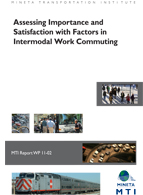- 408-924-7560
- mineta-institute@sjsu.edu
- Donate
Assessing Importance and Satisfaction with Factors in Intermodal Work Commuting
Users of multiple-mode public transportation were compared to users of privately owned vehicle (POV) transportation in work commuting within two different travel corridors of Santa Clara County, California. In the first corridor, high tech companies were the source of questionnaire respondents; in the second corridor, the respondents were predominately municipal and county office employees. Most intermodal travel in the first corridor was with multiple buses. In the second corridor, commuters who used a bus and light-rail combination were studied.
Survey results from the sample of work commuters who faced a multiple bus combination in travel in the High Tech corridor indicate uncertainty, travel time and distance (the distance from residence to initial mode, interface between modes, and from final stop to work location) were rated as more important, but lower in satisfaction by POV commuters than by public transportation commuters. Results of Importance-Satisfaction Analysis (ISA) of ratings indicated that for POV commuters, travel time, uncertainty, and distance were factors in the quadrant of high importance and low satisfaction, which is most relevant managerially. In the ratings of public transportation commuters, wait time was clearly the factor in this quadrant. Cleanliness and uncertainty were lower satisfaction factors close to the boundary of the high importance quadrant. In survey results from a sample of work commuters to an urban city center who faced a light-rail and bus combination, POV commuters rated most factors as more important, but less satisfactory than commuters who used public transportation. The differences of largest magnitude in both importance and satisfaction were in cost, total travel time, and distance. The largest difference between POV and public transportation commuters in this corridor was in cost.
Design implications of the studies differ across travel corridors. Whereas in the High Tech corridor, improving factors of wait time, travel time, and uncertainty appear to have a priority over cost for both public and POV work commuters. The results in the Downtown corridor suggest the opposite. For public transportation commuters in this corridor, cost is the most important factor. The differences in results in the comparisons across public transportation commuters and POV commuters in each sample strongly suggest that independent studies of travel corridors with different travel mode alternatives can be informative and have different managerial implications, even when they are within the same county.
STEVEN SILVER, PhD
Steven Silver is a Professor in the Lucas Graduate School of Business and College of Business at San José State University. He has earned an MA and MBA from the University of Chicago, a PhD from the Haas School of Business, University of California, Berkeley and has been a visiting scholar and post-doctoral fellow at the London School of Economics and at Stanford University. Dr. Silver has authored numerous reports and publications in consumer behavior, urban economics and measurement methodology. He has also served on advisory groups and panels for management of the arts and the design of transportation-related programs.
-
Contact Us
San José State University One Washington Square, San Jose, CA 95192 Phone: 408-924-7560 Email: mineta-institute@sjsu.edu






